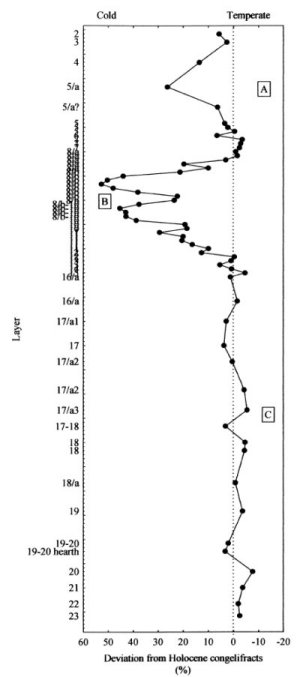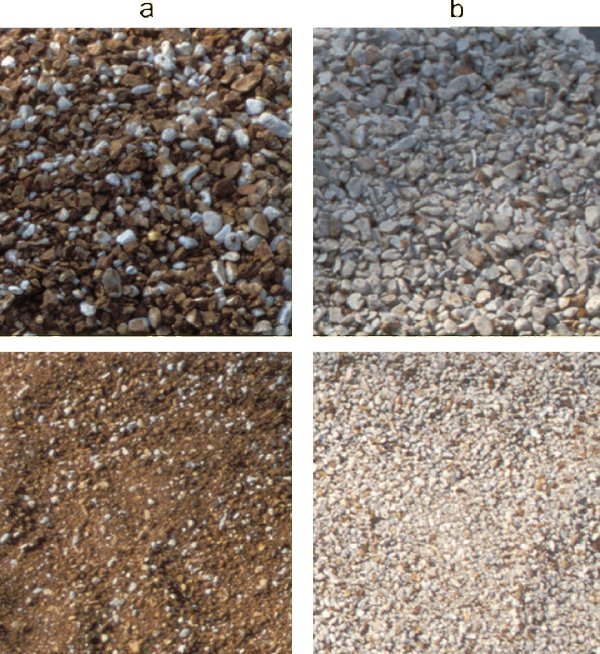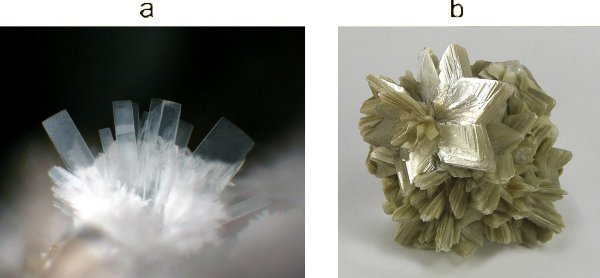 Institute of Archaeology Institute of Archaeology |
[Slovenian] |
| Home | Members | Programme | Projects | Laboratory |
| Database | Publications | Library | Links | Archive |
|
DIVJE BABE I. Upper Pleistocene Palaeolithic site in Slovenia 5. Sediments at the Divje babe I site
5.1. Generally about sediments Abstract The majority of what is dealt with in this sub-chapter has already been described and translated into English in Turk, Bastiani 2000 and Turk et al. 2005. Sub-chapter 5.1. is essentially a summary of the state of general research and methodology of work in the sphere of sedimentology. More specific themes are dealt with in the following sub-chapters, which also introduce some innovations into this sphere.
5.2. Morphological characteristics of clasts and climato-stratigraphy
5.3. Aggregates, breccia and climato-stratigraphy Abstract Some themes dealt with in this sub-chapter have already been described and translated into English in Turk et al. 2005 and Turk 2005; 2006. Authigenic soil aggregates served for an approximation of palaeohumidity, whereby the results well matched approximations of palaeohumidity on the basis of cavernously corroded clasts. Cave bear played a decisive role in the creation of both aggregates and cavernously corroded clasts, contributing phosphate binding and organic acids. On the basis of soil congelifracts and aggregates, we obtained a climatogram of the site. Climatic approximations for palaeotemperature and palaeohumidity show that colder periods were generally more humid, which means that there was also more precipitation. This does not correspond to the majority of explanations to date of climate in the Upper Pleistocene on the basis of cave sediments and simulations of climate in MIS 3 for the Mediterranean and Southeast Europe on the basis of heterogeneous data from 380 palaeolithic sites (Barron et al. 2003). A peculiarity in the sediments is the breccia in layers 6, 7, 8, 10, 16, 16a, 18, 18a, 19, 20, 22-24 and 26. The breccia in layers 6/7, 8a, 8c/8b and 8b-10 is characterised by a higher quantity of phosphorus, which originates primarily from bioapatites. A content of phosphorus in breccia is not bound to a specific type of climate. In addition, sporadic appearances of breccia in the profile of the site does not correspond to estimates of palaeohumidity.
5.4. Geochemical analysis of the sand-silt sedimentary fraction Abstract The theme of this sub-chapter was partially dealt with and translated into English in Turk 2006. In the sand-silt fraction we analysed three groups of chemical elements. Ratio between calcium and strontium vary in the profile in the same way as content of phosphate aggregates (see sub-chapter 5.3 in this volume). All this is correlated with the variation of humidity or precipitation and support divison of the profile on four already proposed parts (facies A-B and subfacies C-1 to C-2). Facies A and Subfacies C-2 are similar while facies B and especially subfacies C-1 are very specific in terms of the content of calcium and strontium and their ratio.
5.5. Unusual mineral in a hearth from Divje babe I Abstract A white substance (WS) found by flotation of charred material in hearth layers in Divje babe I was analysed. With the aid of electron microscopy, infrared spectroscopy and diffraction of X-rays, it was found that WS is magnesium 1M muscovite, with an unusual ribbon-like shape of crystal for this compound, so far unknown for this mineral. The presence of WS in and around cave hearths is ascribed to the disintegration of slates, which had been brought to the cave and were found in hearths beside charcoal and charred bones. This raises the suspicion that people used slates by the hearths. The geochemical formation of the ribbon-like WS from slate in Divje babe I cave remains an open question.
*** 2007, (Opera Instituti Archaeologici Sloveniae, 13), 480pp, 10 colour photoogaphs, 178 b-w drawings, photoogaphs and maps, 89 tabels and 38 annexes; 20 x 29 cm, hardcover, ISBN 978-961-254-019-7. |




